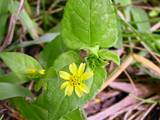Native Plants

Q. Who is Mr. Smarty Plants?
A: There are those who suspect Wildflower Center volunteers are the culpable and capable culprits. Yet, others think staff members play some, albeit small, role. You can torture us with your plant questions, but we will never reveal the Green Guru's secret identity.
Did you know you can access the Native Plant Information Network with your web-enabled smartphone?
Ask Mr. Smarty Plants is a free service provided by the staff and volunteers at the Lady Bird Johnson Wildflower Center.

rate this answer
Wednesday - July 06, 2016
From: Bessemer, AL
Region: Southeast
Topic: Plant Lists, Drought Tolerant, Erosion Control, Shade Tolerant
Title: Plants Needed for a Shaded, Rocky Slope in Alabama
Answered by: Anne Van Nest
QUESTION:
I live in Alabama where the soil is clay and rocky. I've tried planting on a rocky slope I have but, it's also shaded. Not even Juniper will survive on this slope. I've spent thousands of dollars trying to make this area presentable to no avail. And my fixed income just can't handle it anymore. The borders of this area do have some sunlight. Prickly weeds seem to be doing well. I have pictures. :-( I want: Blooms! Maybe something that holds the clay soil but spreads like a groundcover, flowering at different times of year, drought tolerant, some green all year, plant now. Must hate sun.ANSWER:
Sorry for the delay in sending this response! Also, sorry about the challenges to your gardening on a rocky, clay slope in the shade (and for the thistles that have moved in and settled in the area). You really do have a significant challenge with this site. Dry + shade is one of the most challenging. But do not worry, there are some native plants that you can try.
A search of the Native Plants Database on our website at www.wildflower.org/plants/ set to the criteria of Alabama, herb, perennial, shade, dry and 0-1 feet does reveal 14 plants. Some aren't suitable to grow as groundcovers. The remaining ones are:
Horseherb (Calyptocarpus vialis) This shade tolerant groundcover has tiny, yellow daisy flowers and will go dormant during cold winters. It is evergreen in mild areas. Try to keep heavy mats of fallen leaves off the plants. Mow if desired. May need a little extra water to look its best during extended droughts.
White troutlily (Erythronium albidum) A low plant with mottled leaves that makes an attractive groundcover. White blooms in the spring. Plants multiply rapidly by root offshoots and seed, but can require up to 6 years before blooming.
Partridgeberry (Mitchella repens) A trailing evergreen perennial with white, fragrant flowers in pairs. No taller than 2 inches tall, partridgeberry makes an attractive woodland creeper.
Common cinquefoil (Potentilla simplex) A low growing perennial with flowers and leaves arising from runners on separate stalks. Runners are 6-20 inches long. Has five-parted leaves and five-petaled, yellow flowers.
And if you want to use a vine as a groundcover and forgo the blooms, you might consider these:
American bittersweet (Celastrus scandens)
Saw greenbrier (Smilax bon-nox) (beware of the thorns on this plant)
From the Image Gallery
More Erosion Control Questions
Environmentally friendly native erosion control plants for arid hillside in Austin
July 15, 2006 - Hi,
I'm moving into Agave, the new east side development in Austin. It's currently an arid hill with almost no trees and a steep (by gardening standards) hill.
As a community, we'd love to...
view the full question and answer
Need Native Plants for Ditch Stabilization in Texarkana, Arkansas
September 14, 2010 - I live in Texarkana, Arkansas. I have a ditch near the street in my front yard that is approximately 90-100 ft. long. It gets full sun. There is a lot of clay and rocks in the ditch. I need to fin...
view the full question and answer
Erosion Control with perennials for a shady Dallas bank
July 25, 2013 - Thank you for your help with turf or perennials on a shaded bank, 4000 sq ft, for the Dallas area that has good roots, grows in semi shade to shade, is on a steep bank so cannot mow, and flowers the l...
view the full question and answer
Will not cutting grass make its roots stronger?
May 27, 2009 - I live on a lake that has a hill. There is some problem with erosion on the hillside. Our association wants us to not cut the grass to stop the erosion. How does not cutting the grass help the roots g...
view the full question and answer
Connecticut Plants for a Steep Slope
September 09, 2015 - I am looking for the best plants to retain a steep, dry, fully shaded slope in zone 5, Connecticut. It must be deer resistant. Plant height is not a factor.
view the full question and answer
| Support the Wildflower Center by Donating Online or Becoming a Member today. |

